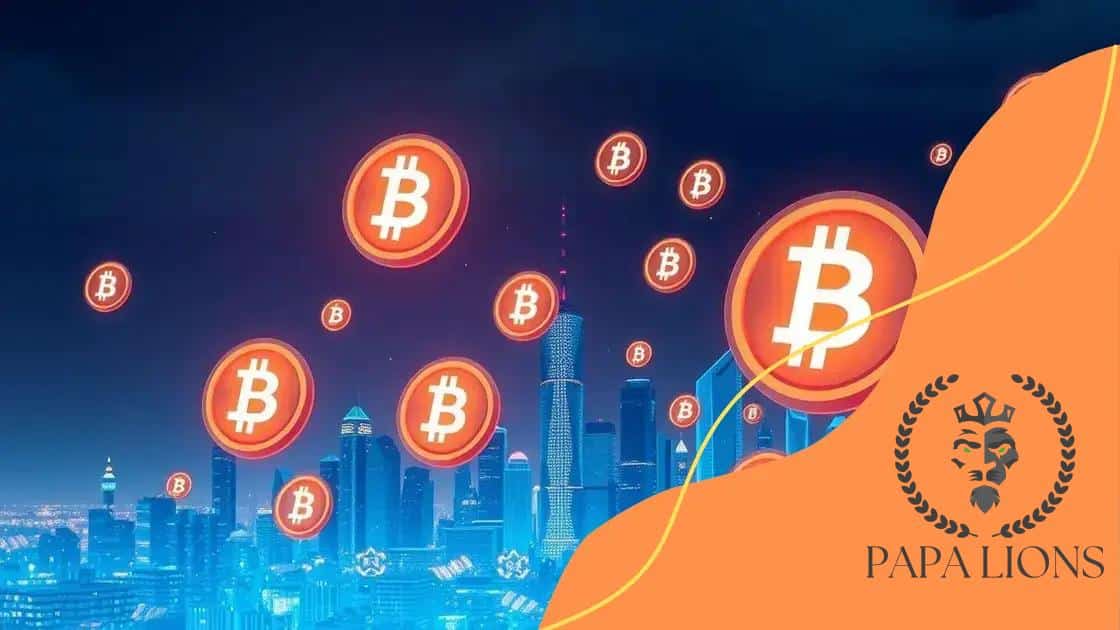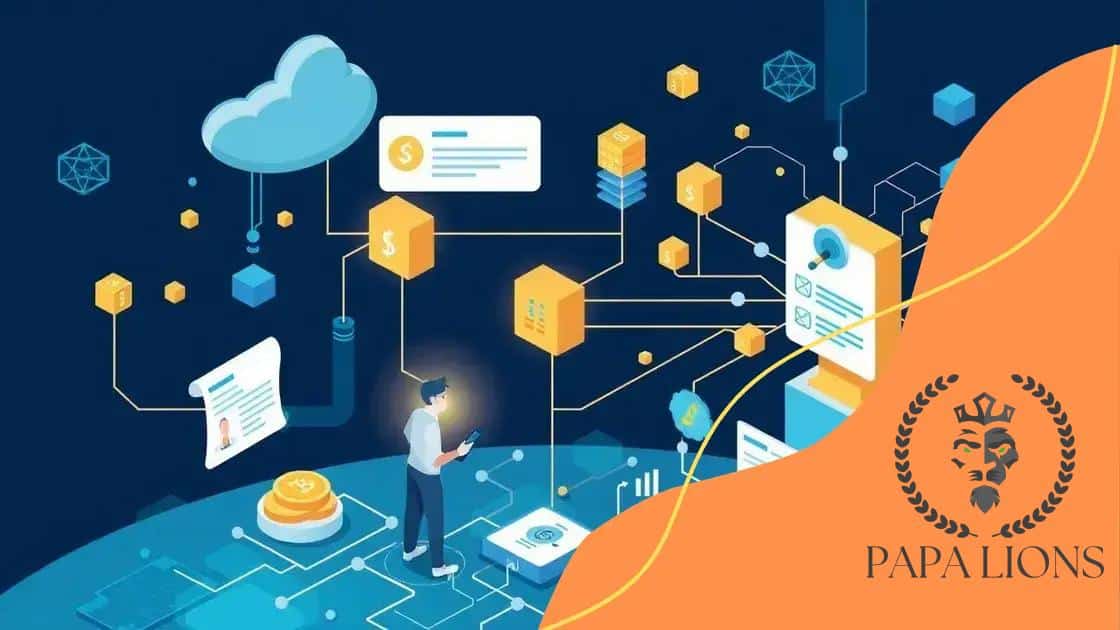DeFi ecosystem developments that you should know

The DeFi ecosystem is a decentralized financial system that leverages blockchain technology to eliminate intermediaries, enabling direct peer-to-peer transactions and a wide range of financial services.
The DeFi ecosystem developments are attracting attention for good reason. With its potential to transform traditional finance, it raises questions about security, scalability, and accessibility. What are these developments, and why should they matter to you? Let’s dive deeper.
Understanding the DeFi ecosystem
Understanding the DeFi ecosystem is crucial in today’s financial landscape. This decentralized financial system is revolutionizing how we think about money, investments, and banking. In a traditional banking setup, there are intermediaries. But in a DeFi system, these middlemen are removed, allowing for greater efficiency and transparency.
One of the foundational components of DeFi is blockchain technology. This technology creates secure and transparent transactions. As users engage with decentralized applications (dApps), they gain access to various financial services.
Key Features of the DeFi Ecosystem
Several vital features define the DeFi ecosystem:
- Smart Contracts: They automate processes, ensuring that transactions are executed automatically when the conditions are met.
- Decentralization: Financial services are operated on distributed networks, minimizing control by single entities.
- Accessibility: Anyone with an internet connection can participate, breaking down geographical barriers.
- Stability Tokens: These are designed to maintain a stable value against traditional currencies, making them a reliable medium of exchange.
These elements showcase how DeFi stands apart from conventional finance. Additionally, the ecosystem promotes innovation and the development of new financial products that cater to users’ needs.
Risks of the DeFi Ecosystem
While there are many advantages, risks also come with such a system. Smart contracts, although beneficial, can have vulnerabilities. These weaknesses could lead to exploitation and financial losses. Moreover, the regulatory environment around DeFi is still evolving, and potential legal implications remain uncertain for users.
In summary, the DeFi ecosystem offers unique opportunities while presenting challenges. Understanding its features, rewards, and risks can empower users to navigate this rapidly changing financial world effectively. Staying informed and cautious is key to thriving within this innovative landscape.
Key trends shaping DeFi developments
Key trends are shaping the DeFi developments landscape and transforming finance as we know it. As the world embraces digital finance, these trends not only enhance accessibility but also drive innovation. Understanding these trends is essential for anyone looking to engage with the DeFi ecosystem.
Rise of Decentralized Exchanges
Decentralized exchanges (DEXs) are becoming increasingly popular. Unlike traditional exchanges, DEXs eliminate the need for intermediaries, allowing users to trade directly with one another. This direct interaction enhances security and privacy, as users retain control over their funds.
- User Control: DEXs give users complete ownership of their assets.
- Anonymity: Trading on a DEX often requires no personal information.
- Lower Fees: Transaction fees on DEXs can be significantly lower than those on centralized platforms.
This rise signifies a shift toward greater user empowerment in the DeFi space.
Integration of Layer 2 Solutions
Another significant trend is the integration of layer 2 solutions. These solutions, such as Optimistic Rollups and zk-Rollups, help scale DeFi applications. By processing transactions off-chain and then settling them on the main blockchain, these systems reduce congestion and lower costs.
Users benefit from faster transactions and reduced fees, making it easier to engage in trading and other financial activities.
Tokenization of Assets
The tokenization of real-world assets is another crucial trend. By converting physical assets like real estate or gold into digital tokens, DeFi expands the scope for investment and liquidity.
Investors can buy fractions of these assets, which lowers the barrier to entry. This democratization of investment opportunities can attract more participants to the market.
Overall, the key trends shaping DeFi developments emphasize security, efficiency, and accessibility. As these trends continue to evolve, they pave the way for an increasingly inclusive financial system.
The role of smart contracts in DeFi

The role of smart contracts in DeFi is foundational. These self-executing contracts facilitate, verify, and enforce agreements on the blockchain. Unlike traditional contracts, smart contracts operate without intermediaries, providing increased efficiency and reducing costs for users.
Smart contracts are programmed to perform specific actions once predefined conditions are met. For example, if the terms of the contract state that a payment should occur when an asset is listed, the contract automatically executes the payment. This automation eliminates human error and enhances reliability.
Key Benefits of Smart Contracts
Using smart contracts in DeFi offers several advantages:
- Transparency: All parties can view the terms of the contract and track its execution on the blockchain.
- Security: Smart contracts use cryptographic security, reducing the risk of hacking or fraud.
- Cost-Effectiveness: By minimizing the need for intermediaries, users save on fees typically associated with traditional transactions.
- Speed: Transactions are executed quickly since they depend on the automated processes of the smart contract.
These benefits clearly illustrate why smart contracts are integral to the growth of the DeFi ecosystem.
Common Use Cases
Smart contracts facilitate various applications within DeFi. They are used in decentralized finance protocols for lending, borrowing, and trading. For instance, in decentralized lending platforms, smart contracts manage collateral and the terms of the loan, ensuring secure transactions without traditional banks.
Another common use is in yield farming, where users earn returns on their crypto assets. Smart contracts automate the processes involved in providing liquidity and reward distribution, making it easier for users to maximize their returns.
The role of smart contracts in DeFi continues to evolve, with ongoing innovations and improvements in technology. Their ability to enable trustless interactions makes them a crucial component in the future of finance.
Challenges faced by the DeFi ecosystem
The DeFi ecosystem faces several challenges that can hinder its growth and adoption. Understanding these obstacles is essential for participants and investors alike. While DeFi presents opportunities, it also comes with risks that need careful consideration.
Security Risks
One of the most significant challenges is security. Smart contracts, while innovative, can be vulnerable to hacking. If a code flaw is exploited, users may lose their funds. Recent incidents highlight the need for thorough audits and improved security measures.
- Code Vulnerabilities: Bugs or vulnerabilities in a smart contract can lead to exploits.
- Phishing Attacks: Users may fall victim to scams designed to steal personal information and funds.
- Governance Risks: Decentralized protocols rely on community governance, which can lead to poor decision-making.
These security concerns can deter new users from engaging with DeFi platforms.
Regulatory Challenges
Another challenge is the regulatory landscape. As DeFi grows, governments and regulatory bodies are still trying to understand its implications. This uncertainty can create a risk for users. Platforms may face scrutiny or changes in regulation that impact their operations.
For example, questions about asset classification, taxation, and anti-money laundering requirements are all on the table. Clearer regulations could help legitimize DeFi, but until then, uncertainty remains.
Scalability Issues
Scalability is also a major concern. Many DeFi platforms face issues with processing high volumes of transactions quickly. Congestion on the Ethereum network, for example, can lead to high gas fees and delayed transactions.
To mitigate this, developers are exploring layer 2 solutions, but widespread adoption takes time. Ensuring smooth user experiences is crucial for the long-term viability of DeFi.
Overall, the challenges faced by the DeFi ecosystem include security risks, regulatory uncertainty, and scalability issues. Addressing these will be vital for fostering growth and gaining broader acceptance.
Future predictions for DeFi innovations
Future predictions for DeFi innovations are exciting and complex. As technology evolves, it is expected that DeFi will continue to expand its impact on the financial system. Several trends suggest how this evolution may unfold in the coming years.
Increased Interoperability
One significant trend is the move towards increased interoperability between different blockchain networks. This means that various DeFi platforms may start to work together more seamlessly. Users will be able to transfer assets and data between different ecosystems without hassle.
This interoperability aims to enhance user experience and make decentralized finance more accessible. Imagine using one platform for trading while leveraging another for lending without friction.
Enhanced Security Measures
As DeFi continues to grow, so does the emphasis on security. Future innovations will likely include advanced security protocols to protect users and their assets. Improved smart contract auditing practices will become standard to mitigate vulnerabilities.
Developers are expected to adopt bug bounty programs and robust testing frameworks. This proactive approach may significantly decrease security breaches in the DeFi ecosystem.
Integration of Artificial Intelligence
Another prediction is the integration of artificial intelligence (AI) into DeFi platforms. AI can analyze vast amounts of data rapidly, helping users make informed decisions. Predictive analytics may guide investment strategies and improve risk management.
By using AI, DeFi platforms could offer personalized financial advice and create tailored investment products, making the space more user-friendly.
Tokenization of More Assets
The trend of tokenizing assets is likely to expand further. As regulation evolves, we may see a broader range of assets converted to digital tokens. Real estate, fine art, and even stocks could become accessible to everyday investors.
This shift will democratize investment opportunities and encourage participation in the DeFi ecosystem. More people will have the chance to invest in previously inaccessible markets.
The future of DeFi innovations holds substantial promise. With advancements in interoperability, security, AI integration, and asset tokenization, the landscape is set for revolutionary changes. These developments will reshape how we engage with finance and create a more inclusive economic environment.
In conclusion, the DeFi ecosystem is evolving rapidly, promising exciting innovations and opportunities. Future trends like increased interoperability, enhanced security measures, and the integration of artificial intelligence open up new possibilities for users. As more real-world assets become tokenized, access to investment opportunities will broaden. However, challenges such as security risks and regulatory uncertainties still need to be addressed. By staying informed and adapting, participants in the DeFi space can navigate this dynamic landscape successfully and contribute to a more inclusive financial future.
FAQ – Frequently Asked Questions about DeFi Ecosystem Developments
What is the DeFi ecosystem?
The DeFi ecosystem is a decentralized financial system that uses blockchain technology to remove intermediaries from transactions, allowing for direct peer-to-peer interactions.
How do smart contracts work in DeFi?
Smart contracts are self-executing contracts with the terms of the agreement directly written into code. They automate processes and ensure transactions occur when conditions are met.
What are the main challenges facing DeFi?
The main challenges include security risks, regulatory uncertainty, scalability issues, and the need for improved user education about the technology.
What innovations can we expect in the future of DeFi?
Future innovations may include increased interoperability between platforms, enhanced security measures, integration of AI for data analysis, and broader tokenization of real-world assets.





